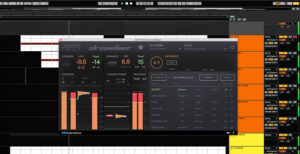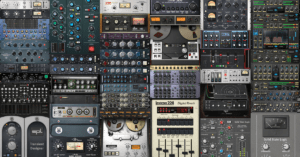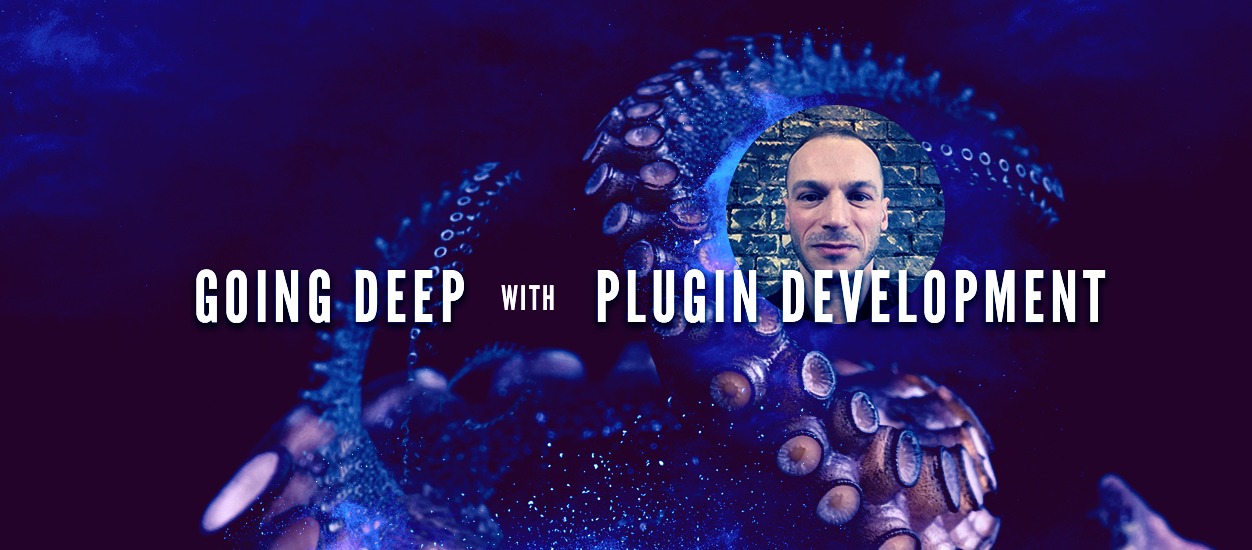We all use them. We all know about them. But what really goes on behind the scenes (and hood) of plugins and plugin development? Since 1992, with Waves first audio plugin called the Q10 Paragraphic EQ, we have seen a massive rise, and overall must-have scenario for audio plugins. It is surreal to think back and realize that at one point and time there was no recall and everything was in analog domain. The past 30 years have been a constant battle for Plugin Developers to take center stage. Marc Adamo, the developer behind ADPTR, knows this best, and this is why we decided to interview him about how this all works, and about his new plugin out now on Plugin Alliance called Streamliner.
First, a little background about Marc. Marc and I met at the Waves hang in Los Angeles at NAMM in 2020. I have done a lot of work for Waves as Audio Journalist and Marc has been a heavyweight industry hitter for many years, and working with all the plugin giants. His first plugin on Plugin Alliance called Metric A/B (Watch Video about METRIC AB here) is one of the most sought after referencing plugins on the market for mixing and mastering engineers alike. And now, with the new Streamliner (which I was an Alpha tester for), is going to be the MUST HAVE for ALL mastering and mixing engineers in the modern era. No joke! So lets dive in deep into plugin development and how this all goes down behind the curtains.

BOS – What is your role in the plugin industry? Walk us through a day-to-day basis for yourself.
Marc – Strictly speaking, I’m a product owner/designer/stakeholder. I come up with the concepts for plugins when I’m working on music, write them down, do a little design work, then start talking to my development team and other music producers about the ideas. If they have legs, I get deeper into it, and start sketching out the concepts and working on specification and use cases.
On a day to day basis, it’s Emails, Skype, Basecamp, spec docs, design work and maybe a little bit of testing in Logic or Ableton. It’s all about pushing the project further, keeping momentum going, dealing with the problems and keeping the faith in the project.
BOS – Plugins are obviously this biggest part of the audio industry in recent years, and have been for quite some time. How much has the plugin industry grown when looking at it from the inside?
Marc – Well, I’m old enough to have already been around when Steinburg invented VSTs, and it’s been growing steadily ever since. But in the last 5 years we have seen an exponential rise in the number of developers and products. I think the main reason for the explosion has been that there are two sides of development; the fun stuff – like DSP and the boring stuff ‘the framework and SDK’. Believe it or not, the SDK (software development kit) takes longer to get right, and encompass so much more tech than a lot of the DSP side. So if you where a fantastic DSP developer, you still had to spend a hell of a lot of time developing an SDK, framework and libraries to do all the boring stuff like UI, audio routing, automation handling, file reading, text and graphic displays etc. Then, there’s the formatting for the different plugin types, VST, AAX, AU etc. That’s why some developers never released AAX or windows versions of their plugins. Because they didn’t have the time, resources or motivation to work out all the problems themselves to take them there.
So, the big breakthrough came when tools like JUCE came along and solved so many of the tedious problems that every developer needs to solve in order to produce all the formats. Now any developer can use JUCE as the foundation of their product, and to produce industry standard formats without the hassle of doing it all yourself. When you look at all the effort everyone was making just to solve the same problems, and replicate the same technology, it’s no wonder that JUCE has had such a big impact on the plugin boom. Well done Jules and the JUCE team for taking the pain out of the proverbial a** of development.
BOS – As a plugin is developed, what are the stages that are done to make it from concept to reality? What does it take for a plugin to be born?
Marc – It all starts with an idea, sometimes that idea is a “what if?” as in, what happens when I mess around with this DSP, what sounds can it produce?
Sometimes it starts with a pain point – why is it such a [pain in the butt] to do this right now, and how can we make it easier and better?
And other times, it’s as simple as ‘I want that vintage hardware sound in the box’.
Once you have the concept, you need to break down the use cases to inform you about the design and technology required to produce the outcomes you desire.
UX is a big factor with plugins that are either complex or totally new things that don’t have an established way of working. You really need to work hard here to make sure that the user experience is seamless. It’s a lot of hard work iterating and refining the workflow to ensure that the user doesn’t ever see how complicated things are working in the background.
Then you move onto the developing the technology, prototyping, testing and iterating it until you get to the Alpha version. Once you have a stable alpha, you can refine the final design and snag all the operational bugs and produce a beta. After a few rounds of beta testing, and listening to the users feedback, you produce the Release Candidate (RC) and if all goes well, you got yourselves a release!
BOS – How long does it take to develop a plugin?
Marc – I will give you the answer that most developers give me when I ask them the same question – ‘It Depends’, and that is the most honest answer I can give you.
BOS – You are known for one of the best known referencing plugins (for both pro’s and beginner producers) with your plugin Metric A/B released on Plugin Alliance. Can you give us some behind the scenes info on how this came to be?
Marc – The truth is, I never ‘wanted’ to create plugins, I am not a developer, so I never tinkered with code, and I was happy making music with all the great plugins that were out there. Until, one fateful day when I was getting very frustrated trying to reference tracks while doing a mix.
I had several reference tracks that a client gave me, and I was doing all these workarounds to try to A-B the references with the mix I was working on. Jumping between iTunes and Logic, and Logic became very laggy. Trying to loop sections of the reference track just wasn’t happening with media players. Trying to juggle solo’s and mutes to hear sections of the reference in Logic was awkward and cumbersome. It all just felt wrong. I knew one of the biggest problems was that I was losing vital information by not being able to instantly compare the two tracks with a simple A-B process.
So I started to imagine the ideal way to do this, and I saw a parallel with switching systems that are used to switch between sets of monitor speakers in the studio. That was the genesis of the A-B button. It seems kind of obvious, but why was no-one else doing it? The next thing I looked at was DJ software, this informed me on the handling of Cue and Loop markers, waveform representation etc.
I started with an open mind, and just pieced it all together over the evening with photoshopped bits of screen grabs of plugins and some fine herbs.
After studying all the workflow habits and potential use cases, I produced numerous iterations of the layout until I had something solid that worked for 99% of the situations I envisioned. At this point I started showing it to my producer friends to see what they thought. I had plenty of ‘yes m8, I need you to do this’ and quite a few ‘that’s stupid I don’t need to reference tracks to do a good mix’ and it even caused some producers to defend their workarounds as better than using a plugin.
But the real takeaway was that there were plenty of guys who thought it was a great idea and would use it, so that drove me to get it done.
If you ever read a ‘new product’ thread on Gearslutz, you will notice that there are always three types of comments from those camps; it’s either ‘i don’t need it’, or ‘thats stupid’ or the ‘wow, take my money now!”
BOS – I am not sure I am even allowed to mention this, so feel free to ignore this question, but I know you have a new plugin about to be in Alpha testing… can you shed any light on this? If it’s not too soon, of course.
Marc – The new plugin from ADPTR tackles the contentious and confusing art of mixing and mastering for Streaming platforms. For better or worse, Streaming has become the primary way we listen to music now, so something needed to be done, and we’re doing it.
*** Since this article was written it has now come out on Plugin Alliance. The plugin is called “Streamliner”.
I, personally, was very excited and grateful to be an Alpha tester for this plugin due to my career in Mastering. It is a God-send plugin for knowing how your master will end up (sounding and levelling) on all platforms, while also allowing you to A/B and continue your workflow. I will be doing a breakdown article on this soon for here at Black Octopus Sound. Check it out HERE! or watch the video HERE

BOS – How many people are typically involved with getting a plugin made? What roles do they play?
Marc – Well, you have some one man operations that design, specify and code their plugins as lone wolves, and on the other end of the spectrum you have bloated teams where the developers are instructed by the product designers who are handed directions from the marketing team who get their orders from out of touch CEOs who are pandering to their VC guys.
ADPTR is on the lean side, and we like it that way. I have a small team of highly skilled developers who work on specific aspects of plugins, and we come together to produce the final product. I handle the concept and design, and get help from a talented UI designer to ensure that the final look of the product is as functional, professional, and beautiful as possible. Once we have a product we then have to do several rounds of alpha and beta testing and QC to ensure that it is close to perfection as possible before it gets released. The team at Plugin Alliance has been amazing at helping us raise the bar of quality and reliability that is essential for a professional application.
BOS – Do you think plugins can replace analog gear? And if not yet, do you think it will happen someday?
Marc – I’d say that analog is only half the story, hardware is the other half, and plugins won’t ever replace hardware as there are always scenarios where hardware is a better option.
But we have also seen the rise of software in a box as a reliable and high quality solution for live events and just from an inspirational and performance vantage.
As far as analog modelling is concerned, yes, some plugins are so close to the real thing that you can’t tell the difference in a blind test, but one thing that software will never replace is the lust and fetish for analog equipment. When you want to experience the sensual connection with an analog synth or feel the heat from a tube compressor as you rotate the knobs, you cant and won’t ever get that feeling from software.

BOS – Where do you see the future of plugin development? Do you see a bubble bursting any time soon? Will there ever be too many plugins?
Marc – If we go strictly by quality and original ideas, then there are already too many plugins that just copy something else or don’t meet the sound quality gold standard. But there are plenty of good ideas still to come, loads of super helpful utilities that need to be made to make life easier, loads of classic FX that could be reimagined to be more effective for current product styles and let’s not forget all the breakthroughs in DSP which will expand sonic frontiers in ways we could only imagine a few years ago.
As far as the bubble bursting, I have thought about this, and for an analogy I look at the guitar pedal boom as a parallel scene that has exploded in recent years.
What’s really happening is that technology has become more democratised, the barrier to entry is lower and access to components and fabrication processes has become easier for everyone. It’s no longer a centralised marketplace with a few big companies dictating the market and innovating technology. It’s now in the hands of anyone who has ideas, drive, passion and some financing options.
The amazing thing is, If we have ideas, we can connect with like minded people anywhere in the world to complete the skill group necessary to produce a finished product.
With more diversity in ideas, the scene attracts more diverse creative types who are drawn to a type of tool which helps them express their personal style and suits the creative workflow much better than the homogenous designs that typically roll out from the larger corporations. It’s not just a case of the pie being sliced into smaller pieces, its the fact that the pie now has more flavours and textures than ever before. This means that more people are going to find their ideal slice of pie, which is how it should be.
Thank you to Marco and his team for all that they have done in the plugin world! Be sure to check out his latest plugin Streamliner HERE, and his well known hit pluging Metric A/B HERE
Website
Instagram : @adptr_audio
Youtube: ADPTR AUDIO
